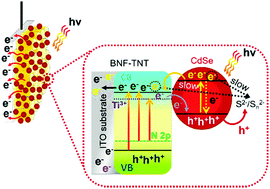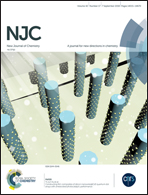The role of boron in the carrier transport improvement of CdSe-sensitized B,N,F-TiO2 nanotube solar cells: a synergistic strategy†
Abstract
The synergistic effects of different engineering strategies, especially interface engineering, band structure engineering, and micro/nano engineering, can be exploited for the development of efficient photoanodes for quantum dot-sensitized solar cells (QDSSCs). Herein, we investigate the energy transfer mechanism and the charge carrier transport capacity of a set of photoanodes developed for a CdSe QDSSC. Boron, nitrogen and fluorine-tridoped TiO2 nanotube (BNF-TNT) membranes were obtained by anodization of titanium to self-organized TiO2 nanotube (TNT) layers, followed by a lift-off process. Then BNF-TNT membranes were adhered onto indium–tin oxide (ITO) conductive glass and sensitized by varying the load of CdSe quantum dots (BNF-Y-CdSe) using the SILAR method. The as-prepared electrode materials were characterized by FESEM, HR-TEM, DRS, XPS and Raman spectroscopy. The photochemical, photoelectrochemical, and semiconducting properties of the electrode materials were investigated by photopotential, photovoltammetry, photocurrent transient measurements, and Mott–Schottky analyses in 1.0 M Na2S. CdSe quantum dots (QDs) were homogeneously and intimately coated on BNF-TNT, which favored electron transport to the ITO substrate, and promoted a red-shift in the light harvesting of the composite toward the visible region (1.65 eV) from UV (2.75 eV). The highest photoresponse was obtained for BNF-TNT grown in 0.06 wt% H3BO3, and sensitized with CdSe QDs after five SILAR cycles. Boron doping in BNF-5-CdSe increased the photoconversion efficiency with respect to the CdSe-sensitized nanotubes without B-doping (NF-5-CdSe) by around 176% under one sun illumination (AM 1.5 G, 100 mW cm−2). The results showed that B-doping/sensitization synergism occurs by a Ti3+ states-to-CdSe QD electron transfer, which increases electron flow toward back contact. This allowed the enhancement of the electron lifetime, charge-collection efficiency and incident-to-electron conversion efficiency.



 Please wait while we load your content...
Please wait while we load your content...